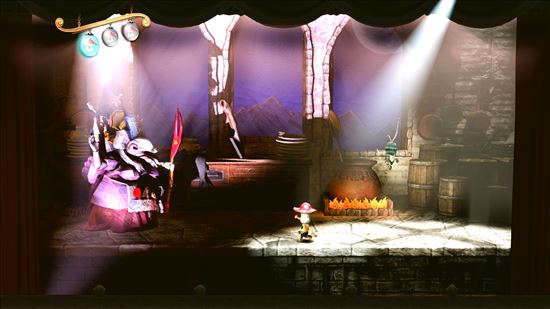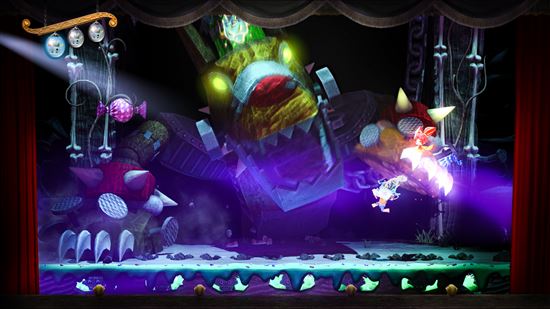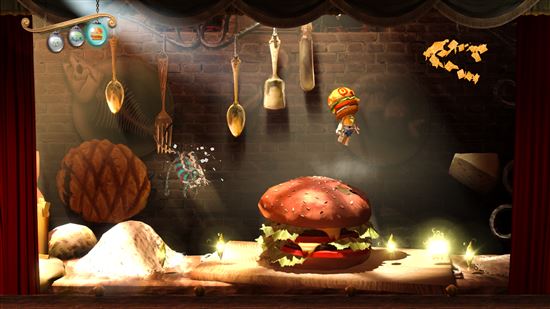Publisher: SCEA
Developer: Japan Studio
Medium: Blu-ray Disc
Players: 1-2
Online: No
ESRB: E10+
Puppeteer is a wonderful, magical platforming experience for the PlayStation 3 that will surely be overlooked by many. That’s a shame too, because it is truly one of the most inventive, enjoyable and totally original side-scrollers to come along this generation. Sure, we loved Rayman Origins and Legends and gushed over the LittleBigPlanet series, but Puppeteer is really something else.
Developed by Sony Computer Entertainment Japan, Puppeteer is sort of a throwback to the quirky platformers of old such as Clockwork Knight, Klonoa, Tomba! or Dynamite Headdy (to name a few). It’s also a distinctly Japanese creation, from gameplay to graphics, which can be considered somewhat rare these days unfortunately.
The bizarre story in Puppeteer sets the stage, quite literally, for an unforgettable and dramatic (again, literally) adventure. The game kicks off with the nasty Moon Bear King kidnapping a boy by the name of Kutaro, turning him into a wooden puppet, yanking off his head and imprisoning his body in an evil black castle… on the moon. Weird, right? But that’s not it. Kutaro’s quest to find his head and escape the clutches of the Moon Bear King takes place on a stage of a magical puppet show, complete with mechanical sets, curtains and a virtual audience which reacts with glee, applause or horror to the events happening in front of them. It makes a whole lot more sense when playing it and the end result is really quite original and shockingly well done. The game’s tone goes from whimsical to dark at the drop of a hat (head?) and the developers walk a fine line between classic Disney and Aesop’s Fables.
Kutaro doesn’t stay headless for long, as he quickly teams up with a puppet cat named Yin-Yang, the Moon Witch and the Sun Princess for help in finding a new head and to show him the ropes. He also quickly comes across a pair of enchanted scissors which serve as a weapon of sorts, and learns of special moon stones and the guardians who are in control of them. During his adventure Kutaro can pick up a wide variety of new puppet heads throughout the game, from a knight or rocket head, to a taiko drum or a squid head, though he can only hold 3 at any given time. The heads don’t provide Kutaro with any new powers or moves per se, they more or less serve as a key to either open up new passageways, make a stage easier to traverse, or unlock a bonus stage. Heads also serve as a life meter, and getting hit by an enemy or obstacle sends Kutaro’s current head bouncing around for a few moments giving him a chance to pick it up. If he loses all three heads, Kutaro is sent back to the last checkpoint in exchange for a continue, which are earned by collecting 100 moon shards. Still following me? Good.
As mentioned earlier, the gameplay mechanics in Puppeteer are definitely unique (it’s difficult to not use the word when describing the game). Sure, Kutaro can run and jump, but using his magic scissors, he can attack enemies and essentially hover through the air while cutting items or enemies made of fabric or paper. The cutting mechanic takes some getting used to and is honestly unlike anything I can remember playing in a platformer. The inventive stages and set-pieces in combination with these scissors make for some incredibly interesting and memorable puzzles and boss fights. Combine that with a trio of new abilities which are earned by taking down some bosses and locating a moon stone, and you have an impressive variety of techniques at your disposal, many of which are utilized in equally unique ways.
On top of all of these gameplay elements comes a co-op ?partner? who can be controlled by using the right analog stick and a trigger, or by another player using a second controller, or preferably, a PlayStation Move controller. This partner (Yin-Yang or the Sun Princess usually) serves as a floating, invincible cursor and can interact with the environment to locate heads and moon shards, clear obstacles, or harass the enemies and bosses in an effort to assist Kutaro. These co-op mechanics add yet another distinctive layer to the gameplay and it all somehow finds a way to mesh together beautifully. Juggling all these elements is easy enough to handle playing solo, though I would definitely suggest having a second player assume control of the partner with a Move controller. Having a second set of eyes and hands poking around to uncover and collect useful items and/or clear out obstacles and enemies streamlines the flow of the game to an extent, and it’s also quite a lot of fun.
Puppeteer may initially look kiddy, but it’s not a pushover by any means. The game takes place over 7 acts, each with 3 “curtains” (levels) and has a comfortable mix of platforming, puzzle soling and epic boss encounters. The game does put up a challenge even though the checkpoint system is fair and it’s nearly impossible to run out of continues. Average gamers should take 7 or 8 hours to get through the game for the first time, and with a nice amount of hidden items, unlockables such as story books, and distinct heads to locate, there is certainly some incentive to replay the stages.
As unique as the gameplay is, the creative visuals presented in Puppeteer are just mind-blowing at times, both technically and stylistically. As touched on earlier, the game takes place on what looks like a stage with wooden puppet-looking characters and mechanized props which slam into place when the curtain rises. The harsh theater spotlights which follow around Kutaro and the layered sets provide a convincing three-dimensional illusion even without a 3D capable set and glasses ( which the game does support and I’d imagine, is amazing). The effects, animation and overall image quality in Puppeteer is nothing short of magical and really needs to be seen in person or in motion to fully appreciate.
Those responsible for the sound design in Puppeteer should win some sort of award too as they?ve done an exceptional job completing the illusion. The virtual audience, amusing voice-work, narration and script, and theatrical music all sync up with the style of the game perfectly. The audio presentation adds a lot to the overall package and it’s not difficult to appreciate the effort the developers put into this aspect.
Even with Rayman Legends out there and Grand Theft Auto V likely sucking up many a gamers’ time, it would be a crime against videogame humanity to overlook Puppeteer. It’s one of the most original and captivating games of the year — on any platform — and for $40 you can’t go wrong.





